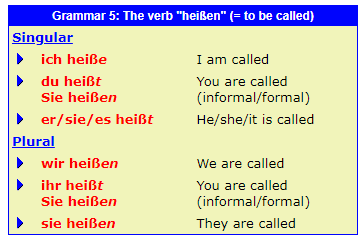The present tense of the vast majority of German verbs is formed from the infinitive of the verb - the part of speech which equates to the English "to do", "to speak" etc. In German, the infinitive almost always ends in "-en". To construct the individual forms, remove the "-en" from the infinitive and add personal endings to the remaining stem as follows:

The verb "heißen" is an example of a "weak" or "regular" verb in that it takes the regular personal endings for a verb in the present tense.
The only distinction is that the verb endings for the "du" person is usually "-st" and not "-t" as here. The reason why it is "du heißt" and not "du heißst" is a logical one - if that were the case, you would have three "s"'s in a row!
The verb "sein" (= to be)
Unfortunately, by no means all verbs are regular. The other verb which we have encountered so far - and also the most commonly used German verb! - is irregular:

 英语
英语 日语
日语 韩语
韩语 法语
法语 西班牙语
西班牙语 意大利语
意大利语 阿拉伯语
阿拉伯语 葡萄牙语
葡萄牙语 越南语
越南语 俄语
俄语 芬兰语
芬兰语 泰语
泰语 丹麦语
丹麦语 对外汉语
对外汉语

